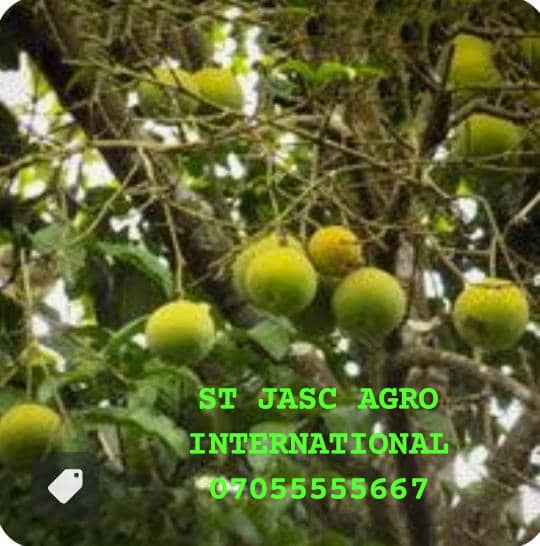ST JASC AGRO INTERNATIONAL BUSINESS
08082249028, 07055555667
Bitter Kola: A Cash Crop with Rich Benefits
Bitter kola, scientifically known as *Garcinia kola*, is a tropical fruit tree native to West Africa. It has gained popularity not just for its health benefits but also as an important cash crop that can significantly contribute to the income of farmers. This blog explores the significance of bitter kola as an agricultural cash crop, detailing its planting techniques, fertilizer applications, harvesting practices, and cultural practices involved in its cultivation.
Planting Techniques
1. Site Selection:
– Bitter kola thrives in well-drained, fertile soils. A site with a pH of 5.0 to 6.5 is ideal. The site should be semi-shaded, as young trees can struggle under full sunlight.
2. Propagation:
– Bitter kola is typically propagated through seeds, which can remain viable for about 3-4 months. Seedlings should be grown in nursery beds for 6-12 months before transplanting. To maintain seed viability, store seeds in cool, moist conditions.
3. Spacing:
– Once ready for transplanting, space the seedlings 4-5 meters apart to allow for adequate growth. This spacing also facilitates air circulation, minimizing the risk of disease.
4. Transplanting:
– Transplant seedlings during the rainy season to ensure they have enough moisture for establishment. Carefully remove the seedling from the nursery bed, taking care not to damage the roots, and plant in pre-prepared holes.
5. Mulching:
– Apply mulch around the base of the seedlings to conserve moisture, suppress weeds, and improve soil fertility as it decomposes. Organic materials such as dry leaves or rice husks work well.
Fertilizer Applications
1. Soil Testing:
– Before applying fertilizers, conduct a soil test to determine nutrient deficiencies. This will guide the type and amount of fertilizer needed.
2. Fertilizer Types:
– A balanced NPK (Nitrogen-Phosphorus-Potassium) fertilizer is recommended. A common ratio is 15-15-15, applied 2-3 times a year, starting after the first year of growth.
3. Application Rates:
– For young trees (1-3 years), apply about 100-200 grams of fertilizer per plant per application. For mature trees (4 years and above), increase the amount to 500 grams.
4.Organic Fertilizers:
– Incorporating organic fertilizers, like compost or manure, can enhance soil structure and promote healthier tree growth. Apply organic materials during the planting and growth stages.
Harvesting Techniques
1. Harvest Timing:
– Bitter kola bears fruit approximately 3-5 years after planting. The fruits should be harvested when they are fully matured, which is indicated by a change in color from green to a yellow-brown hue.
2.Harvesting Method:
– Use a sharp knife or machete to cut the fruit from the tree to minimize damage. It’s best to harvest during the dry season when the fruits are easier to handle and less susceptible to rot.
3.Post-Harvest Handling:
– After harvesting, fruits should be handled with care to avoid bruising. Clean the fruits and store them in a cool, dry place to prolong shelf life. Proper storage can significantly enhance the market value of the product.
Cultural Practices
1. Weed Control:
– Regular weeding is crucial in the cultivation of bitter kola to minimize competition for nutrients and water. This can be done manually or through the use of mulch to suppress weed growth.
2. Pest and Disease Management:
– Monitor for pests such as aphids and caterpillars. Use integrated pest management (IPM) strategies, including natural predators or organic pesticides, to control outbreaks. Employ proper hygiene practices in the orchard to prevent disease transmission.
3. Irrigation:
– Although bitter kola can tolerate moderate drought, providing supplemental irrigation during dry spells can enhance fruit quality and yield, especially during the early growth stages.
4. Pruning:
– Regular pruning helps in maintaining tree shape, enhancing air circulation, and removing dead or diseased branches. Prune during the dry season to avoid introducing pests and diseases.
5. Intercropping:
– Consider intercropping bitter kola with other compatible crops, such as cassava or maize, during the early years. This can provide additional income while the bitter kola trees are establishing.
Conclusion
Bitter kola serves as a vital agricultural cash crop that can bring significant economic benefits to farmers in West Africa and beyond. With appropriate planting techniques, effective fertilizer applications, and careful harvesting, along with diligent cultural practices, farmers can optimize their yield and profitability from this unique crop. As demand continues to rise for bitter kola due to its health benefits and cultural significance, investing in its cultivation can lead to substantial returns in the agricultural sector.
Booking 👇👇
ST JASC AGRO INTERNATIONAL
Call/WhatsApp 08082249028, 07055555667



